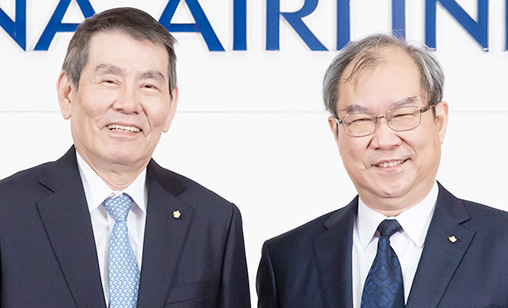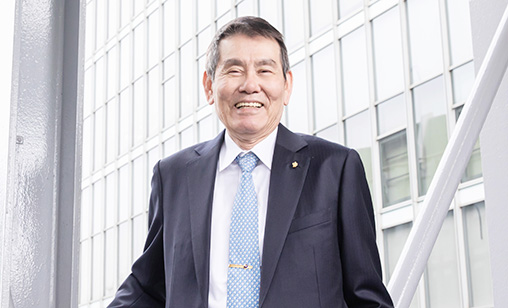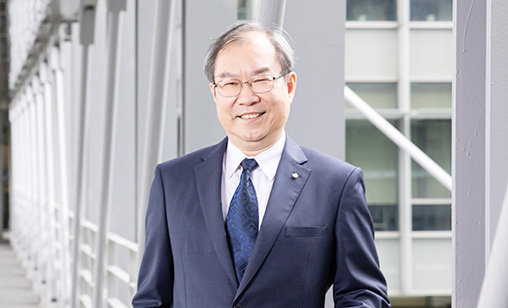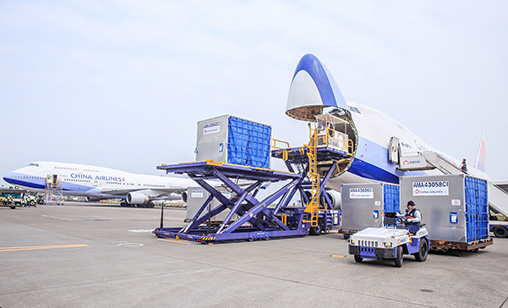Cover Story
China Airlines mantra: prioritise cargo
When China Airlines chairman, Hsieh Su-Chien, and the company’s board confirmed Kao Shing-Hwang as president last March, the resulting leadership duo was a marriage made in airline heaven, a combination of the political and financial sophistication of Hsieh and the operations and cockpit expertise of Kao. Tomasz Sniedziewski reports for Orient Aviation from Taiwan.
February 1st 2022
China Airlines (CAL) has been one of the very few airline companies in the region to successfully reorganize its business to function profitably in the pandemic world. Read More » The rapid introduction of the “Prioritize Cargo over Passengers” business strategy, which resulted in a swift turnaround for the airline group, was conceived and driven forward by chairman, Hsieh Su-Chien, a corporate CAL veteran of more than four decades, who also served as acting president in the first 13 months of the pandemic’s global spread.
In March last year, Kao Shing-Hwang, a pilot and a senior flight operations executive, who began his career with CAL as a flight attendant, joined the leadership team as president, offering his decades of experience in operations to the leadership mix.
 |
“When the COVID-19 pandemic broke out in 2020, as the acting president I decided ‘speed’ was the essence of coping with its impact,” Hsieh told Orient Aviation last month.
“I thought hard about the strengths of China Airlines and came up with ways to maximize their marginal effects.
“Firstly, I tried to improve our liquidity in preparation for a stiff fight. Then I issued an “SOS” signal to let the outside world know the airline industry needed government relief. The next step was self-recovery - when the global airline industry began to recover.
“China Airlines introduced active fund management, based on ‘finding new income sources and cutting costs’. We took advantage of government emergency loans, landing fee discounts and epidemic prevention subsidies to keep our business and finances on an even keel.”
But it was CAL’s decision, adopted as early as March 2020, to prioritize cargo that has proved to be its winning strategy. It is now the main source of revenue for the flag carrier.
“Full support was given to cargo to ensure the continuity of Taiwan’s supply chains for electronics and epidemic prevention supplies. This also kept [and will keep] China Airlines passenger operations running to welcome the rush of returning customers once the airline industry recovers,” Hsieh said.
“We strengthened Taiwan’s position as a transshipping hub and established ourselves in promising markets, making the most use of air rights and freighter capacity. The Air Cargo team stepped into the breach and adopted a flexible “Prioritize Cargo over Passengers” business strategy.
 |
“The belly-hold on passenger aircraft is being used to supplement the freighter network while resources such as passenger/freighter fleets, routes and networks also are being integrated.”
Relying on cargo for revenue has historically helped China Airlines survive and thrive in the past, Kao said.
“The resilience of cargo always has proved vital during life and death moments for CAL. The SARS (2003-2004) epidemic, for example, generated a record breaking performance,” he said.
This time around, it has proved to be no different. “Cargo’s outstanding performance resulted in an 88% jump in revenue in 2020. It now accounts for more than 90% of total revenue,” said the CAL president.
CAL’s revenue in the first three quarters of 2021 was TWD 81.11 billion (US$2.92 billion), an increase of 45% year-on-year,” Hsieh said.
But “the most important goal during the pandemic has been epidemic prevention and safety”, he said.
The carrier has spared no efforts to guarantee the safety of the aircraft crews and travelers. It took to issuing one-time key cards to crew members to prevent them leaving their rooms during quarantine. It also disinfects all check-in luggage on arrival.
Unquestionably, Hsieh’s career experience with CAL is playing a pivotal role in navigating the company through the pandemic crisis.
“I joined China Airlines in 1979 and have been with the company for 43 years. I started as a junior accountant then switched to sales and marketing. I headed affiliates such as Abacus Taiwan and Taiwan Air Cargo Terminal and was stationed at CAL offices in Indonesia, Australia and several other countries,” he said.
| “Government policy and quarantine bubbles mean pilots must endure a never-ending cycle of quarantines and missions. The result is physical and mental fatigue as well as extended separation from their family.” “Their spirit of sacrifice, devotion and professionalism should serve as a model for all front-line personnel serving the nation. China Airlines thanks all the pilots for their contribution and hard work during the pandemic.” |
“This experience has provided me with a very deep knowledge of CAL’s passenger and cargo operations, domestic and overseas businesses, and its financial structure.”
That does not mean life has been easier for Hsieh than for his peers across the region. “I was faced with all kinds of immense pressure during the decision-making process. It is a crisis of unprecedented proportions but as long as you stay calm and concentrate on doing what’s right for the Taiwanese economy and the long-term development of China Airlines, then you are on the right track.”
In March 2021, very soon after his appointment as president, Kao was confronted with his first leadership challenge. After months of no local infections, Taiwan recorded its first serious outbreak of COVID-19.
“I took over as president in mid-March 2021 when the COVID-19 pandemic had already wreaked global havoc for a year. Taiwan’s epidemic prevention efforts had proved largely successful until then, but the virus inevitably broke through,” recalled Kao, who like Hsieh is a company veteran.
“I have been with China Airlines for 36 years. I passed the China Airlines exam to become a flight attendant in 1986. After working with pilots, I became interested in flying and in 1988 I joined the first in-house pilot training program. I completed my professional training overseas, funded by the company, and became a pilot in 1988. I have flown A300-B4s, A300-600Rs, A340s and A330s among other aircraft types.
“I am currently qualified on the 747-400. In addition to my management role, I continue to fly missions on a regular basis.”
Kao explained: “my first task was to ensure the safety of all employees. Aircraft crews on the front line that travel between different countries were particularly critical. Once the vaccinations started, I immediately registered for one as a pilot to encourage aircraft crews to do the same. A vaccination station was set up within the company office to make vaccines as accessible as possible to crew members and other employees. This not only improved protection for employees and their families but also gave passengers peace of mind.”
All pilots and cabin crew have received two doses of the vaccine and a third booster shot is now being administered,” Hsieh said.
 |
“Our top priority was a balance between epidemic prevention and operations. Agile dispatching for passengers and cargo saw China Airlines and our management team deliver a strong result in 2021 despite the devastation in the global airline industry. China Airlines in effect became the “Guardian Airline” watching over the economy of Taiwan”, Kao said.
Safeguarding Taiwan’s economy comes at a price for frontline airline staff. Until now, Taiwan has adopted a “Zero-COVID” policy. It requires pilots to follow safety protocols at home and abroad that are often more strict than their peers based in the countries that have decided to open their borders.
“Pilots have cooperated with changing quarantine and epidemic prevention measures for nearly two years. In addition to the normal professional and aviation safety considerations, they also frequently fly to other countries where the risk of exposure to COVID-19 is high. Nevertheless, they continue to carry out their mission of ensuring the safe delivery of crucial materials.”
“The aircrews serving the carrier can count on special measures introduced during the pandemic, designed to help physical and mental well-being, including the willingness to hear the feedback. China Airlines is tending to the physical and mental well-being of aircraft crews, setting up a 24-hour hotline to provide crew members with professional assistance, quarantine advice and medical attention or interactive online physical fitness video courses to help crew members stay fit. “Every effort is made to ensure crew members have timely access to medical assistance and resources when necessary,” said Kao.
But the pandemic has not dampened enthusiasm for a career as air crew, he said. “China Airlines continues to recruit pilots to meet our operational needs. COVID-19 has not interrupted our recruiting efforts and we will continue to reach out to universities in 2022,” said Kao. “Being a pilot is more than just a job. It is a great honor. Pilots flying for China Airlines make an important contribution to the Taiwanese economy and play a vital role in the global cargo movement. If you are a pilot with great ambitions, then China Airlines welcomes you,” he said.
“Passenger flights were adjusted as necessary to gradually rebuild the visibility of our network and meet the demand from students, businesses and workers with special travel requirements during this period. We also supported the government’s travel bubble campaign, tweaked our services to meet traveler demand and even played the role of the “fire brigade” on a number of occasions, assisting with the repatriation of passengers from Wuhan and the Diamond Princess cruise ship at the government’s request,” Hsieh said.
| Committed to Tigerair “Tigerair Taiwan purchased the “Tigerair” trademark outright in 2021. We plan to continue developing the brand to ensure its long-term sustainability,” said CAL chairman, Hsieh. Closed borders have made business tough for the LCC. In 2020, the airline reported net losses after tax of approximately TWD1.37 billion. Despite the losses, Tigerair’s fleet renewal program, commenced in 2021 as planned, will include the A320neo. “It is of strategic importance to the CAL Group, offering differentiated products for different market segments,” said the chairman. “China Airlines will continue to operate in the LCC market through Tigerair Taiwan in the future.” |
The carrier boosted passenger services demand by offering clients the ability to book a block of seats or even charter the whole section of the passenger cabin.
“The current uncertainty in the COVID-19 situation and passenger market means there are no plans to add passenger routes at the moment. Our focus will be on maintaining services on core routes,” said Hsieh, and added there might be necessary adjustments to services to keep fares reasonable.
“Business travel is expected to be greatly reduced and traveler confidence has not yet fully recovered. China Airlines will, therefore, adopt a cautious approach to the passenger market,” Hsieh said.
 |
Post COVID, the latest aircraft type to be entering CAL’s fleet, the A321neo, will become the mainstay aircraft of its Northeast Asia, Southeast Asia, and cross strait routes. “This aircraft features contactless service and enhanced epidemic prevention measures. Upgrades include Premium Business Class with fully-flat seats, the latest entertainment system and the airline’s largest screen displays, high-speed in-flight Wi-Fi, and free text messaging,” Hsieh said.
“To enhance our cabin services, we now provide products with the same comfort specifications as our wide-body fleet. And the 10%-20% increase in cargo capacity makes a valuable addition to our current cargo-centric operations.”
In 2022, eight more A321neo will arrive at the airline. At the same time, the carrier will retire three 737-800s. Even the days of 737s are numbered although CAL is offering a wireless entertainment system upgrade on these aircraft.
“In addition to offering benchmark-setting products targeted at the high-end passenger market in Asia, we hope the differentiation of cabin equipment will help us compete for the high yield segment as well,” said the CAL chairman.
The company’s the wide-body aircraft fleet also is changing. “Four 747-400 passenger aircraft were retired ahead of schedule last year. We continue to explore the feasibility of a new wide-body passenger aircraft replacement for the A330-300 fleet,” he said.
The upgrades of the fleet might benefit CAL as the Taiwan operating environment becomes more competitive. Apart from its long-time rival, EVA Air, newcomer STARLUX Airlines is competing with CAL for full-service customers.
But Hsieh is not worried about CAL’s position in the market, thanks to “an unbeatable advantage in cargo”.
“COVID-19 is still having a major impact on the air transport market and airlines need cargo to generate revenue. Flexible adjustment of transportation capacity is therefore of the utmost importance,” he said.
Nor does Hsieh feel competitive pressure from low-cost carriers (LCCs) as their business model is too different from full-service carriers such as CAL. “Travelers themselves differ in their expectations and needs as well so each has a distinct market segment,” Hsieh said.
The airline group, however, has not shied away from adopting some LCC pricing tactics. “We have introduced the “Fare Family” pricing structure system in response to competing LCCs and to meet the planning requirements and pricing expectations of different travelers. Travelers can customize their fare, select luggage allowance, manage mileage and ticket refund, and modify their booking,” Hsieh said.
Challenges facing CAL in 2022 are rising costs, scheduling constraints for aircraft crews, necessary additional physical and mental health management resources, idle passenger aircraft capacity, questions about traveler confidence and inconsistent recovery in regional markets.
There even is worry about long-lasting changes to the market, such as will working from home lead to structural changes in business travel.
Despite all the challenges, several market factors centred around cargo will be good for China Airlines business, the CAL leadership told Orient Aviation.
“As the global economy continues to recover, the demand for air freight is increasing and the shift from sea to air freight continues to pay dividends. Other factors such as an imbalance in supply and demand and low inventory levels are having an effect,” Kao said. He believes the pandemic is showing signs of easing in Southeast Asia and is encouraged that production in China is back on track.
“Three more 777F freighters will be delivered during 2022 and 2023. These will join the existing 21 freighters in the fleet and allow for more rolling adjustments to the allocation of passenger and freighter aircraft capacity, making a significant contribution to our business performance in 2022,” Kao said.
Fortunately, capital markets have a positive outlook for the carrier. “In the first three quarters of 2021, net profit to the owner of the company was TWD1.555 billion and EPS (earnings per share) was TWD0.28. CAL was, therefore, the first Taiwan-flagged airline to turn a profit in 2021. The S&P Global Company has revised its rating outlook to stable from negative,” Hsieh said.
| CAL aims for net zero emissions earlier than 2050 airline industry deadline “China Airlines has long been interested in environmental sustainability and climate change issues. We were the first airline in the world to obtain ISO 14064-01 greenhouse gas inventory, ISO 14067 carbon footprint and Carbon Reduction Label certifications,” said CAL president Kao. “We also became the first airline in Taiwan and the second in the world to obtain the environmental system management (ISO 14001) and the energy system management (ISO 50001) certifications.” For many years before his promotion to president, Kao was responsible for the airline’s sustainability strategy. “The COVID-19 pandemic has created a very challenging business environment for the airline industry, but even so, in 2021, our long-term investment in sustainability was enhanced and recognized when we were included in the DJSI (Dow Jones Sustainability Index) for the sixth consecutive year. And we beat our own previous record by placing second across the global airline industry in sustainability and emissions reductions. “We have set a target of reaching “net-zero carbon emissions” from business activities before 2050. Initiatives intended to reach this goal include the continued procurement of more fuel-efficient next-generation aircraft, the use of sustainable alternative fuels and across the board adoption of the latest fuel-saving technologies. Since 2012, CAL, along with several airline peers, has been a participant in the Pacific Greenhouse Gases Measurement (PGGM) project. “We have provided A340-300s and A330-300s for trans-Pacific climate observations. We were the first airline in Asia to be involved in GHG observations. Our aircraft also was the first in the world to co-operate in gathering atmospheric data over the Pacific,” Kao said. |
princejerrykhalil says:
December 26th 2025 10:43pm